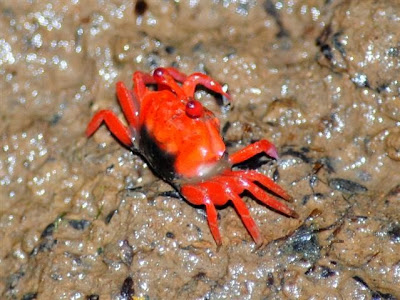I'm back on the monthly guided walks of Naked Hermit Crabs at Chek Jawa as a nature guide. Accompanying me on the trips for September and October are my student councillors who were present as part of the council's Excel leadership exposure programme.
On our September walk, we have two young but super passionate guides in my group- Sankar and Yin Xin. Here's Sankar on the left sharing about hornbills in Ubin.
The group that came for the September walk was fortunate to spot a snake! This long and skinny snake in bright green is a Oriental whip snake (Ahaetulla prasina)!
As it looks like a green vine from far, it is also known as the Green vine snake. Despite its slender and long body form, it also has a long thin tail that can take up nearly 40% of the length of the snake. It eats mainly lizards, but also frogs and small birds.
This snake is mildly venomous but shy and will prefer to slide away into the undergrowth. If you want to take a closer look at it, avoid disturbing it.
Here's a photo of Yin Xin getting upclose with the elegant snake without posing any obstructions or threat to the shy fellow.
There are lots to see on the coastal boardwalk! What can we see as we look down to the shore from where we were standing?
One of the interesting sightings would be many of these mudskippers! They are actually very well camouflaged on the sand and rocks and we wouldn't be able to spot them easily if they are all motionless.
Along the fringe of the coastal forest we do also get a chance to see many birds that we normally wouldn't see in our urban environment such as this Magpie robin.
The group out on the October trip had the opportunity to spot several jellyfish swimming near the surface of the water at high tide.
One of the coastal plants that I would definitely share with my group would be the Sea hibiscus (Hibiscus tiliaceus). They usual start flowering in the morning and the flower will fall by evening time.
Underneath their heart-shaped leaves, we can sometimes find colourful Cotton stainer bugs (Dysdercus decussatus). The ones shown in this photo are juveniles.
My first time upclose with the Mangrove stink bugs (Calliphara nobilis)! The colours of these bugs are beautiful, a reddish copper with a metallic sheen.
Going deeper into the back mangroves, we saw more types of mudskippers such as this Blue-spotted mudskipper (Boleophthalmus boddarti).
Here's a closer look at the mudskipper with its interesting blue spots!
Occasionally, we do stumble upon the Malayan water monitor (Varanus salvator) which is known to be a good scavenger along the coast and mangroves.
There are many crabs at the mangroves of Chek Jawa ranging from tiny ones to huge ones. This tiny yet bright red crab is a Tiny colourful fiddler crab (Uca sp.).
Here's another fiddler crab that is slightly larger with a pale blue or green carapace.
This is a Face-banded sesarmine crab (Perisesarma sp). It is as named because it has a has a bluish band across its face. These crabs are great scavengers. They feed on all kinds of stuff, from sediment to leaves to smaller invertebrates.
Here's another crab that looks like the Face-banded sesarmine crab but I'm not too sure of its identity.
Kwan Siong shared with me his find of this tree-climbing crab grabbing a smaller of its own kind. Is this some kind of mating ritual? :)
I managed to catch a glimpse of this fish swimming in the mangrove pools and am not sure what it is. Any idea?
Another new sighting for myself would be this moth (Westermannia sp.) found along the trail. Thanks Jacqueline for the id.
It's heartening to see that the wild boars are still doing fine around the entrance area of Chek Jawa. They never fail to amaze the visitors.
As usual, we would end off with a guestbook's time where we get to pen down our thoughts and drawings about the trip.
It's usually a time where all sorts of creativity is unleashed. Here's a collage of the action from the September trip.
And a lovely photo of my student councillors with their art pieces in front of House No. 1.
My October group is so on that every single of them produce their own artwork! Great!
Thank you all for your enthusiasm, has been great guiding all of you.
And of course, a group photo of my students from the October trip.
The highlight of the October trip would be the dugong sighting by Ley Kun and Ian! They saw it just off the boardwalk before where the front beacon is located.
I'm filled with jealousy for missing but definitely am happy to know that they are spotted by our crabs! This sighting is so awesome that the otters that they also found were out-shadowed. :P
Read the NHC blog to see photos of the dugong: http://nakedhermitcrabs.blogspot.sg/2013/10/dugong-and-more-at-chek-jawa.html
Links to my student councillors' reflections:
Jeremy: http://shscexcel.blogspot.com/2013/10/environmental-exposure-reflection-by_9442.html
Marcus: http://shscexcel.blogspot.com/2013/10/environmental-exposure-reflection-by_18.html
Yu Chong: http://shscexcel.blogspot.com/2013/10/environmental-exposure-reflection-by-yu.html
Nikki: http://shscexcel.blogspot.com/2013/10/environmental-exposure-reflection-by.html


































No comments:
Post a Comment